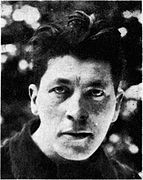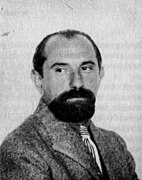
De Stijl
De Stijl (/də ˈstaɪl/; Dutch pronunciation: [də ˈstɛil], Dutch for "The Style"), incorporating the ideas of Neoplasticism, was a Dutch art movement founded in 1917 in Leiden, consisting of artists and architects.[1] The term De Stijl is also used to refer to a body of work from 1917 to 1931 created in the Netherlands.[2][3] Proponents of De Stijl advocated pure abstraction and universality by a reduction to the essentials of form and colour. They simplified visual compositions to vertical and horizontal, using only black, white and primary colors.
This article is about the artistic movement. For the album by The White Stripes, see De Stijl (album).
De Stijl is also the name of a journal—published by the Dutch painter, designer, writer, and critic Theo van Doesburg—that propagated the group's theories. Along with van Doesburg, the group's principal members were the painters Piet Mondrian, Vilmos Huszár, Bart van der Leck, the architects Gerrit Rietveld, Robert van 't Hoff, the sculptor and painter Georges Vantongerloo, the architect J. J. P. Oud and the writer Anthony Kok. The artistic philosophy that formed a basis for the group's work is known as Neoplasticism—the new plastic art (or Nieuwe Beelding in Dutch).
According to van Doesburg in the introduction of the De Stijl, the movement was a reaction to the Dutch expressionist architecture of the Amsterdam School movement.
History[edit]
Early history[edit]
From the flurry of new art movements that followed the Impressionist revolutionary new perception of painting, Cubism arose in the early 20th century as an important and influential new direction. In the Netherlands, too, there was interest in this "new art". However, because the Netherlands remained neutral in World War I, Dutch artists were not able to leave the country after 1914 and were thus effectively isolated from the international art world—and in particular, from Paris, which was its centre then.
During that period, Theo van Doesburg started looking for other artists to set up a journal and start an art movement. Van Doesburg was also a writer, poet, and critic, who had been more successful writing about art than working as an independent artist.[9] Quite adept at making new contacts due to his flamboyant personality and outgoing nature, he had many useful connections in the art world.






